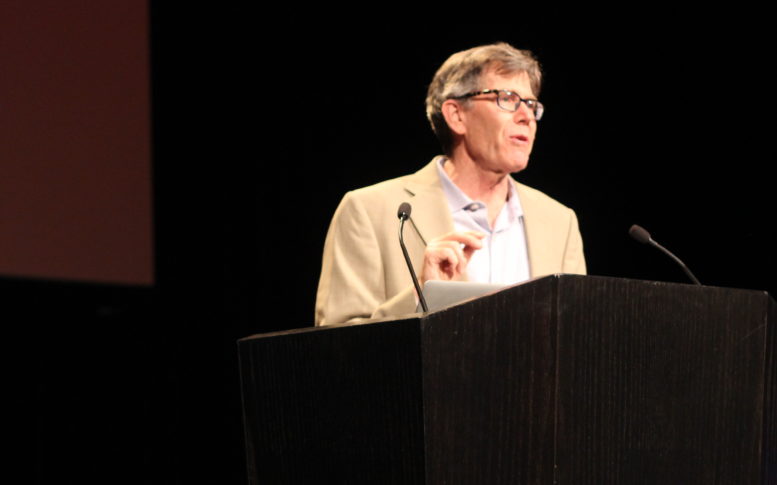By DAVID DUPONT
BG Independent News
In his lecture “Temporary Landscape: Literature of Place,” novelist Lawrence Coates made an observation that to the young writers in the audience may have seemed like a challenge: no great novel of place has been written about Toledo or its environs.
Ohioan Sherwood Anderson posited the metaphor that each place is a brick in the wall that is America. And each brick, whether it is William Faulkner’s Yoknapatawpha County or Anderson’s own Winesburg, Ohio, modeled after Clyde, is needed to make that wall complete. This is according to Susan Straight’s map and essay “The American Experience in 737 Novels.”

Image of moving vans is projected during Lawrence Coates Spotlight on the Arts lecture.
Coates, who teaches in Bowling Green State University’s Creative Writing program, has worked on adding his own brick to the wall. The native of northern California has focused on the Santa Clara Valley, now known as Silicon Valley. Before that it was known by other more fanciful names – The Glorious Garden Without Walls, The Valley of the Heart’s Delight, The Poor Man’s Paradise, and The Garden of the World. The last name Coates plucked for the title of his novel about winemaking in the 1920s.
In his Spotlight in the Arts lecture, Coates focused on his first novel, “The Blossom Festival” and his most recent “The Goodbye House.”
He opened his talk with a passage from “The Blossom Festival.” Boys are playing on the site of what was a railroad yard. All they know is that it’s a place to play, not that it was once an orchard, or a place the Spaniards grazed cattle, or friars raised grapes, or a seed meadow for the native Ohlone people.
The Blossom Festival of the title was started by the preacher Sunshine Williams to celebrate the flowering of the valley’s million fruit trees. The event had parades, concerts, all you’d want for a civic celebration, including speeches.
Coates said to research the novel set between the World Wars, he read, on microfilm, all the coverage of the festival by local newspapers. A speech delivered by politician James Phelan caught his attention. At the time, Phelan was considered a progressive and a reformer who as mayor had broken up the corrupt political machine in San Francisco. His speech wrenched the author from any sense of unmitigated nostalgia.
Phelan, who ended his career in the U.S. Senate, was vehemently racist, especially against the Japanese. His campaign slogan was Keep California White.
The fiction of place that Coates both practices and celebrates is more than sentimental regionalism.
The fiction of place deals with both the visible landscape, what is seen and the invisible landscape of communal associations, Coates said, citing the work of Kentucky writer Wendell Berry.
The fiction of place, Coates said, must take into account the economic underpinnings of a place. The ecological roots – “Do they know where their water comes from?”
It must also consider the gender norms and racial dimensions.
“The Goodbye House” is set in the same place that has become a very different place. The Blossom Festival was not revived after World War II. The orchards rapidly gave way to suburban tract development.
That development, spurred on by the GI Bill, had distinct racial overtones. Areas were graded based on their credit worthiness. Some areas were redlined as unworthy of credit, including mortgages. Those red-lined areas were disproportionately where African-Americans lived. Restrictive covenants in developments also helped ensure that they stayed white.
“The Goodbye House” is set in those suburbs after the 9/11 attacks and during the dot-com meltdown.
Those suburbs are often viewed, he said, as sterile, materialistic places. Coates said he in his younger more callow days used to tell this joke. “What’s the difference between the suburbs and yogurt? Yogurt has a living culture.”
But, he said, the suburbs can also be viewed as the middle ground celebrated by Thomas Jefferson. The frontier, Jefferson believed, was barbaric. The cities were corrupt. It was in those pastoral tracks between that virtue flourished.
Coates posed the question whether the suburbs represented a climax community akin to the Redwoods, or whether they were another temporary landscape like those that had come before it in the valley. And were the Redwoods, trees with interlocking roots, that have sustained themselves for 1,000 years permanent? After all, 1,000 years in not long in the history of the earth.
While these questions, seemingly more the stuff of non-fiction, hang over the fiction of place, the novel retains its pull on the heart. These stories invite the reader into the characters’ world. “If you invite somebody into your home,” Coates said, “it gives you that sense of empathy the best fiction gives.”





